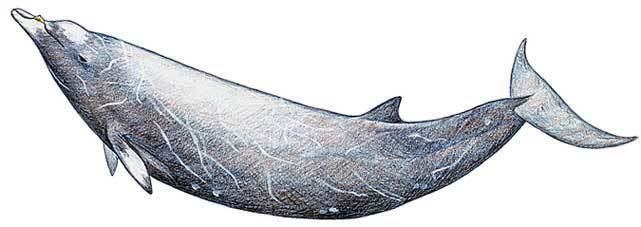Scientific name Mesoplodon carlshubbi | Phylum Chordata Order Artiodactyla Family Ziphiidae Rank Species | |
 | ||
Similar Andrews' beaked whale, Pygmy beaked whale, Perrin's beaked whale, Ginkgo‑toothed beaked whale, Hector's beaked whale | ||
Hubbs' beaked whale (Mesoplodon carlhubbsi) was initially thought to be an Andrews' beaked whale when discovered by ichthyologist Carl Hubbs; however, it was named in his honor when it was discovered to be a new species. This species has the typical dentition found in the genus, but its main outstanding features are a white "cap" on the head and very extensive scarring. The species is known from 31 strandings and one possible sighting.
Contents
Taxonomy
Carl Leavitt Hubbs, a noted American ichthyologist, published a description of a whale found alive in the surf near his office at the Scripps Institution of Oceanography in La Jolla, California, in 1945. He believed it to be Andrews' beaked whale (a very similar species found only in the Southern Hemisphere), but Joseph Curtis Moore, an expert on beaked whales at Chicago’s Field Museum, reassigned it to a new species, Mesoplodon carlhubbsi, in 1963, naming it in his honor.
Physical description
The body is fairly typical for a Mesoplodon, except it is more rotund in appearance and tapered at the ends in a sort of spindle shape. The beak is of moderate length, and the lower mandible almost arches over the rostrum, similar to the condition in a Blainville's beaked whale, but less extreme. The teeth are fairly large, sit on the apex of the jaw, and are slightly higher than the rostrum. After the teeth, the jaw slopes down to form an otherwise typical-looking beak. The coloration in males is dark gray to black without countershading and has white patches on the beak, on the bulbous melon (a "beanie" cap), and have extensive scarring which also appears white. Females and juveniles are a lighter gray on top and countershade to white below, and sometimes have white on the beak as well. They reach a length of 5.4 meters (18 feet) and weigh 1500 kg (3300 lbs) for both males and females. They are around 2.5 meters (8 feet) long when born, the longest in proportion for any beaked whale: 46% of the mother's length.
Population and distribution
The whale lives in the North Pacific, in the east it is limited to Japan and in the west it ranges from British Columbia to California. They may live in the open ocean in between the two areas, but no observations have been made. Because of their presumed small range, they may be rare, but nothing is known for certain about their population. Two individuals died on the shore in Japan in early April 2015.
Behavior

Little is known about their behavior due to the infrequency of sightings (only one known); they probably travel in small groups like the other species. Due to the extreme amount of scars present on adult males, there probably is more male competition compared with other members of the genus. They are believed to feed on squid.
Conservation

The species has been occasionally killed by Japanese whalers and has been caught in driftnets off California. Recent beachings in Hawaii have occurred, supporting the theory of open ocean habitation by this species.
